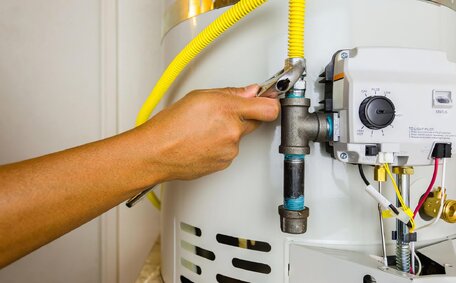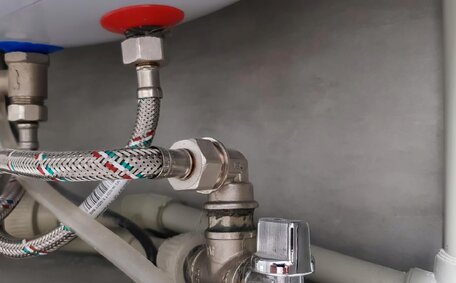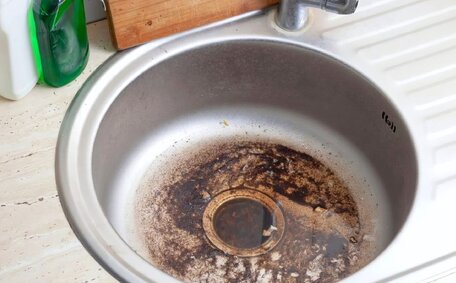What Causes Low Water Pressure in Homes?
There are several common causes of low water pressure in homes:
- Old or corroded pipes - Over time, mineral deposits and corrosion can build up inside pipes, narrowing the interior diameter and restricting water flow.
- Partially blocked pipes - Debris, sediment, and mineral deposits can accumulate and partially block pipes, impeding water flow.
- High water demand - Too many fixtures running water simultaneously can result in a temporary drop in water pressure.
- Undersized pipes - If the home’s water supply pipes are too narrow, they may not deliver adequate water volume and pressure.
- Failing water pressure regulator - Regulators control water pressure coming into the home, and if faulty, can cause low pressure.
- Tree roots - Roots from nearby trees can grow into and block exterior water and sewer lines.
Issues like corroded galvanised pipes, partial clogs, or invasive tree roots will generally worsen over time if not addressed, resulting in increasingly insufficient water pressure. Consulting a plumber can help diagnose and remedy the specific causes.
How Pipe Corrosion Can Lead to Low Water Pressure
As pipes age, corrosion can develop both inside and outside the pipes. This corrosion has a direct impact on water pressure.
On the interior of pipes, corrosion causes mineral deposits and sediment to build up. This buildup narrows the diameter of the pipe over time, restricting water flow. Even a small amount of corrosion and scale can decrease water volume and pressure.
Externally, corroded pipes develop pits, cracks and leaks. As pipes corrode from the outside, they become weaker and more prone to breaking and bursting. This allows water to escape the system, resulting in insufficient pressure.
Pipe corrosion can also lead to partial blockages from detached scale and sediment. These obstructions impede water flow and contribute to poor pressure. The more corroded the pipes, the greater the deterioration of water volume and force.
Tree roots can accelerate external corrosion by scraping pipe exteriors. Root invasion can also cause burst pipes when roots grow into cracks or openings. This worsens existing corrosion damage.
Replacing severely corroded pipes is the most effective solution for restoring adequate water pressure. Pipe relining is a trenchless method that can renew corroded pipes from the inside to improve flow and pressure without the major disruption of full replacement.
What is Pipe Relining?
Pipe relining is a trenchless method of repairing damaged pipes without having to dig them up. It involves inserting a resin-saturated liner into the existing pipe and curing it to form a smooth, seamless interior.
The liner bonds to the old pipe walls, essentially creating a 'pipe within a pipe’. Once cured, the liner restores flow capacity and seals leaks and cracks in deteriorated pipes. Epoxy, polyester, and vinyl ester resins are commonly used.
Pipe relining can renew drainage, water, gas and sewer pipes. It is suitable for a range of materials including cast iron, steel, copper, concrete, clay and PVC. Relining extends the life of pipes for decades while avoiding excavation damage.
Compared to traditional pipe replacement, relining is less invasive, with minimal surface disruption. It also typically costs 60% less while providing improved flow and pressure. The process usually takes just one to two days with no interruption to service.
Pipe relining helps address low water pressure and other issues caused by aged, corroded plumbing. With a typical lifetime of 50+ years, it is an effective and durable repair solution.
How Pipe Relining Works
The pipe relining process involves several key steps:
- Pre-inspection – The existing pipe is inspected using a camera to assess condition and determine if relining is appropriate.
- Pipe cleaning – The pipe interior is thoroughly cleaned to remove any debris, grease, mineral deposits, etc.
- Resin preparation – Epoxy, vinyl ester or polyester resin is prepared and vacuum-impregnated into a felt liner.
- Liner installation – The impregnated liner is inserted into the pipe through an access point and positioned.
- Curing – Hot water or steam is pumped into the liner to cure and harden the resin, bonding it to the old pipe.
- Reinstatement – Service to the pipe is reconnected without excavation or disturbance.
Pipe relining is a trenchless solution that renews old pipes efficiently. The process adds decades of life, restores water flow and pressure, and prevents leaks. With experts handling the technical aspects, homeowners can gain peace of mind knowing their plumbing is revitalised.
The Process of Relining Pipes
Relining pipes is a multi-step process that renews old plumbing from the inside:
- Inspection - A camera probe is fed through the pipes to assess condition and suitability.
- Cleaning - The interior is scrubbed and flushed to remove buildup and debris.
- Resin saturation - A felt liner tube is saturated with epoxy resin.
- Installation - The liner is winched into the damaged pipe and positioned.
- Curing - Hot water or steam inflates and hardens the liner for several hours.
- Finish - The renewed pipe is reconnected to restore service.
At each step, experienced plumbers use specialised equipment to complete the pipe relining with precision. The process is non-invasive, avoiding major demolition or yard excavations. With proper pipe assessment and repair techniques, relining can restore flow and water pressure, as well as seal cracks and leaks caused by corrosion or root damage.
Materials Used in Pipe Relining
Pipe relining typically utilises three main types of materials – epoxy, polyester, and vinyl ester resins. Each has advantages making them suitable for certain applications.
Epoxy resins are the most popular and widely used. They provide excellent adhesion, durability, chemical resistance and long-term stability. Epoxies are ideal for potable water and sewer pipes.
Polyester resins are more affordable but still offer good strength and performance. They cure quickly and can be used on damp surfaces. Polyesters work well for stormwater and drainage pipes.
Vinyl ester resins offer a middle-ground option. They have corrosion resistance approaching epoxies but cost less. Vinyl esters perform well in many circumstances when epoxy is unsuitable.
Many modern relining systems combine different resins. Hybrid epoxy-polyester blends give a balance of strength and cost-effectiveness. The resin system chosen depends on the pipe type, condition and service.
resins, pipe relining uses felt, glass or carbon fibre liners. These provide the tube shape when saturated with resin. With quality materials and professional installation, relined pipes can last 50 years or more.
Benefits of Pipe Relining for Low Water Pressure
Pipe relining offers several key benefits for addressing issues of low water pressure:
- Restores flow capacity - Relining smoothes the interior pipe surface, removing corrosion and buildup. This maximises water volume and flow.
- Non-invasive - The trenchless process avoids major property damage from excavating and replacing pipes.
- Cost-effective - Relining typically costs a fraction of full pipe replacement.
- Durable - Epoxy resins provide a long-lasting fix, with an expected lifespan of 50+ years.
- Fast cure time - Hot water curing takes just a few hours, restoring full pressure rapidly.
- Leak sealing - Relining seals cracks and holes that allow water loss and pressure drops.
- Improved pressure - Smoothing scale buildup alone can help regain lost water pressure.
- Root damage repair - Relining prevents root regrowth compared to just clearing roots and debris.
For homeowners dealing with low pressure from corroded galvanised or steel pipes, relining is an effective and minimally disruptive solution. Contact a professional plumber to determine if pipe relining can restore your water pressure.
It’s a Non-Invasive Alternative to Full Replacement
One of the biggest advantages of pipe relining is that it is a minimally invasive process compared to full pipe replacement. Relining repairs pipes from the inside, without the need for major excavation or destruction to floors, walls, landscaping, or other property features.
With full pipe replacement, yards would need to be dug up, concrete torn out, and extensive restoration work done once the new pipes are installed. This can cause major disruption to the property. Pipe relining avoids this destruction, inserting the liner through a small access point.
For interior pipes, only tiny openings need to be drilled into walls to gain entry. No demolition of tiles, cabinets, or fixtures is required. Relining creates very little mess or damage that needs repairing afterwards.
The non-invasive nature of pipe relining makes it ideal for properties where maintaining structural integrity and aesthetics are a priority. With minimal surface impacts, homeowners can refresh their plumbing without impacting lawns, foundations or existing construction.
It Extends the Lifespan of Existing Pipes
Pipe relining is an effective method for extending the lifespan of existing pipes by an additional 30+ years. The process renews aged pipes from the inside out, restoring flow capacity and performance.
During relining, the resin-saturated liner bonds to the interior walls of the pipe. This seals leaks, fills cracks and smoothes out corrosion damage and mineral buildup. It essentially creates a new pipe within the old one.
With traditional pipe replacement, lifespan depends on pipe material. Copper may last 50-70 years, galvanised steel 40-50 years, and PVC 70+ years. Relining can add decades to these expected lifespans at a fraction of replacement cost.
For homeowners dealing with pipes that are nearing the end of their lifespan, causing issues like low water pressure, relining restores functionality. It turns the clock back on pipe ageing for minimal invasiveness and disruption.
It’s More Cost-Effective Than Replacement
One of the biggest reasons homeowners may want to consider pipe relining is the significant cost savings compared to full replacement. Relining pipes costs approximately 60% less on average.
The price of excavating, removing and replacing pipes can be $150-250 per linear foot. But relining comes in around $50-100 per foot. For a home with 50 feet of piping, that’s a potential savings of $5,000 to $10,000.
Relining avoids the major expenses of property destruction, excavation, new pipe materials and extensive restoration work. The limited access points also take less time and labour compared to large-scale digging.
While exact costs depend on many factors like pipe size, material and site conditions, relining consistently provides major cost savings over replacement. With results lasting decades, it is an affordable long-term solution for restoring water flow and pressure without breaking the budget.
When to Consider Pipe Relining
There are several situations when homeowners may want to consider pipe relining:
- Low water pressure - If pressure drops noticeably, relining can restore flow capacity.
- Leaky pipes - Relining seals cracks and leaks to prevent water loss and damage.
- Noisy pipes - The smooth new pipe interior dampens noisy water hammer.
- Foundation settlement - Relining adjusts to slight shifts, avoiding new pipe stresses.
- Root intrusion - Relining stops root regrowth and damage.
- Limited water flow - Buildup removal increases volume to fixtures.
- Pipe corrosion - Relining renews corrosion damage without replacement.
With trenchless access, homeowners can refresh their plumbing systems quickly and cost-effectively. If pipes are underperforming but not critically failing, relining can restore function for decades. Consult a professional to assess if your pipes are suitable candidates for relining.
Pipe Relining vs. Full Replacement
When faced with pipes that are deteriorating and need repair, homeowners essentially have two options – pipe relining or full replacement. There are pros and cons to each method.
Full replacement involves excavating the area to access and remove the damaged pipes. This completely replaces old pipe but causes major disruption and high expense. Yards are torn up and extensive restoration work is often needed.
New pipe is laid and connected.
Pipe relining inserts a resin-saturated liner into the existing pipes and hardens it to form a smooth, leak-free interior. It essentially creates a new pipe inside the old one for a fraction of replacement cost.
Access is through small openings instead of large excavations. Access is through small openings instead of large excavations.
While relining has limitations on pipe condition, it offers a fast, effective and minimally invasive solution in many situations. Homeowners dealing with issues like low water pressure may find pipe relining to be a preferable alternative to full replacement.
Contact the pipe professionals at Castle Hill Plumbing to learn more about these two options and determine the best choice for your situation.






